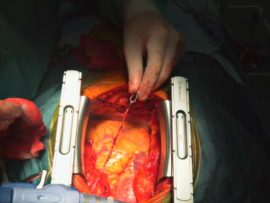Abstract Congenital diaphragmatic hernia (CDH) is typified morphologically by failure of diaphragmatic development with accompanying lung hypoplasia and persistent pulmonary hypertension of the newborn (PPHN). Patients who have labile physiology..
Read MorePulmonary hypoplasia is common in the perinatal period and a significant cause of death in newborn infants. Wigglesworth and Desai reported an incidence of 14.5% in a series of perinatal..
Read MoreAbstract Introduction: Residual pump blood from the cardiopulmonary bypass (CPB) circuit is often collected into an infusion bag (IB) and re-transfused. An alternative is to chase the residual blood into..
Read MoreAbstract Background When comparing effects of on- versus (CABG), it is important to assess the long-term clinical outcomes. However, most research conducted thus far has concentrated on short-term outcomes and ignored..
Read MoreAbstract Background There is still uncertainty about the safety of aprotinin for coronary artery bypass graft surgery. The ART (Arterial Revascularization Trial) was designed to compare survival after bilateral versus..
Read MoreBackground Heparin resistance (HR) is often encountered during cardiovascular operations that require cardiopulmonary bypass. Clinical risk factors and the mechanism underlying heparin resistance are yet to be determined. The aim..
Read MoreAbstract Background Acute normovolemic hemodilution (ANH) is considered safe and effective in decreasing perioperative transfusion in paediatric populations undergoing high blood‐loss surgeries. We determined the association between ANH and the..
Read MoreAbstract Survival analysis incorporates various statistical methods specific to data on time until an event of interest. While the event is often death, giving rise to the phrase ‘survival analysis’,..
Read MoreAbstract Vasoplegia is a ubiquitous phenomenon in all advanced shock states, including septic, cardiogenic, hemorrhagic, and anaphylactic shock. Its pathophysiology is complex, involving various mechanisms in vascular smooth muscle cells..
Read MoreAbstract Objective: To define systemic release kinetics of a panel of cytokines and heat shock proteins in porcine polytrauma/hemorrhage models and to evaluate whether they could be useful as early trauma biomarkers...
Read MoreAbstract Background: Vasopressin is essential for cardiovascular homeostasis, acting via the kidney to regulate water resorption, on the vasculature to regulate smooth muscle tone, and as a central neurotransmitter, modulating..
Read MoreAbstract Purpose: To define some of the most common characteristics of vascular hyporesponsiveness to catecholamines during septic shock and outline current therapeutic approaches and future perspectives. Methods: Source data were obtained from..
Read MoreAbstract In critically ill patients monitored with an arterial catheter, the arterial pressure signal provides two types of information that may help the clinician to interpret haemodynamic status better: the..
Read MoreAbstract Background The role of inflammation in patients with coronary artery disease is emerging. We sought to assess the profile and outcomes of patients with a clinical syndrome of severe systemic..
Read MoreAbstract Introduction: Accurate dosing of protamine reversal following on-pump cardiac surgical procedures is challenging, with both excessive and inadequate administration recognised to increase bleeding risk. We aimed to examine the..
Read MoreAbstract Background: Cardiac surgery on Jehovah's Witnesses (JW) can be challenging, given the desire to avoid blood products. Establishment of a blood conservation program involving the pre-, intra- and post-operative..
Read MoreAbstract Editor’s Perspective What We Already Know about This Topic Major bleeding can occur during cardiac surgery. Although different scoring systems exist, the assessment of bleeding can be variable, and..
Read MoreAbstract Background (CPB) induces a systemic inflammatory reaction that may contribute to . Preventing this reaction with steroids may improve outcomes. We performed a systematic review to evaluate the impact of..
Read MoreAbstract OBJECTIVES Prolonged aortic cross-clamp (XCT) and cardiopulmonary bypass time (CPBT) are associated with increased morbidity and mortality following cardiac surgery. The aim of this study was to assess the..
Read MoreAbstract Survival from out-of-hospital cardiac arrest (OHCA) has remained low despite advances in resuscitation science. Hospital-based extra-corporeal cardiopulmonary resuscitation (ECPR) is a novel use of an established technology that provides..
Read MoreAbstract The “stone heart” syndrome is a rare but often fatal complication of cardiac surgery associated with hypertrophy of the myocardium. The mechanisms behind the syndrome are not fully understood...
Read MoreAbstract Recently, side effects of plasma expanders like hydroxyethyl starch and gelatine gained considerable attention. Most studies have focused on the kidneys; lungs remain unconsidered. Isolated mouse lungs were perfused..
Read MoreAbstract Retrograde lung vascular perfusion can appear in high‐risk surgeries. The present report is the first to study long‐term retrograde perfusion of isolated perfused mouse lungs (IPLs) and to use..
Read MoreAbstract OBJECTIVES Minimally invasive aortic valve replacement (MIAVR) can be technically demanding and may lead to prolonged operative time. We evaluated the intraoperative and postoperative patient outcomes following implementation of..
Read MoreAbstract Acute kidney after cardiac surgery is more common in anaemic patients, whereas haemolysis during cardiopulmonary bypass may lead to iron‐induced renal injury. Hepcidin promotes iron sequestration by macrophages: hepcidin..
Read MoreAbstract Background: Venoarterial extracorporeal membrane oxygenation (VA-ECMO) provides respiratory and hemodynamic support to pediatric patients in severe cardiac failure. We aim to identify risk factors associated with poorer outcomes in..
Read MoreAbstract Background Acute kidney injury (AKI) is common after cardiac surgery and profoundly affects postoperative mortality and morbidity. There are no validated methods to assess risk of AKI intraoperatively. Methods..
Read MoreAbstract Background: The aim of the present study was to investigate the relationship between maximum clot firmness (MCF) in rotational thromboelastometry (ROTEM®) and postoperative bleeding in patients on clopidogrel after..
Read MoreAbstract Introduction: Peri-operative monitoring of coagulation is important to diagnose potential cause of hemorrhage, to manage coagulopathy and guide treatment with blood products in patients undergoing cardiac surgery with cardiopulmonary bypass...
Read MoreAbstract Following cardiac surgery, hyperlactatemia due to anaerobic metabolism is associated with an increase in both morbidity and mortality. We previously found that an elevated respiratory quotient (RQ) predicts anaerobic..
Read More



















